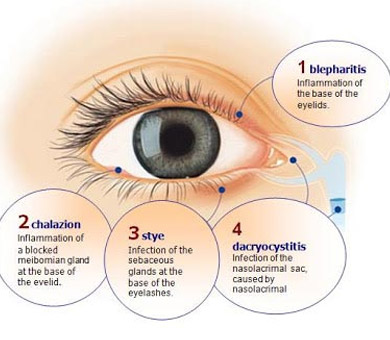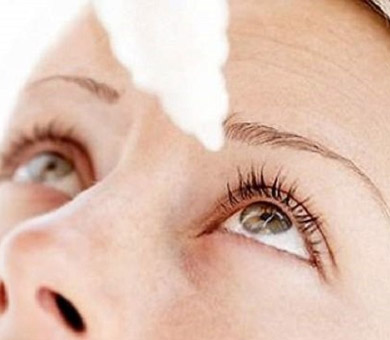What is a Blepharitis?
Blepharitis is an inflammation of the eyelids. It usually affects the edges (margins) of the eyelids.
What is a Blepharitis?
Blepharitis is an inflammation of the eyelids. It usually affects the edges (margins) of the eyelids. It is not usually serious, but may become an uncomfortable, irritating problem and may lead to Stye (Chalazion) formation. Blepharitis is typically chronic (persistent). Both eyes are usually affected.
What are the symptoms of blepharitis?

What are the symptoms of blepharitis?
• The main symptom is sore and irritated eyelids. The eyelids may look inflamed or greasy.
• Sometimes tiny flakes or scales, which look like small flakes of dandruff, appear on the eyelids. Crusts may also develop at the base of eyelashes.
• Sometimes the eyelids also become infected. If they do, the eyes may become 'sticky' with discharge. In particular, the eyelids may stick together in the morning.
• One or more of the openings of the tiny glands of the eyelids (meibomian glands) may get blocked and fill with an oily fluid causing the gland to swell causing a Stye (Chalazion). The glands may also become infected and that can cause damage to eyelashes.
• Many people with blepharitis also produce less tears than normal. This may lead to dry eyes which can cause the eyes to feel gritty, sore, and blurry.
What causes blepharitis?
The exact cause is not known. However Blepharitis is divided by physicians into 2 categories based on where the blepharitis is anatomically originating in the eyelid:
1- Anterior Blepharitis
2- Posterior Blepharitis
Blepharitis tends to 'flare-up' and then ease off in severity. If you have blepharitis, you are likely to always have a tendency to have it. Sometimes, blepharitis gets into a "vicious cycle" where your eyelids may become slightly inflamed and itchy You may then rub them - which makes the inflammation worse This in turn can lead to your eyelids becoming sore You may then keep rubbing them further, which leads to more inflammation, and so on.
What is the Treatment for Blepharitis?

What is the Treatment for Blepharitis?
There is no one cure for Blepharitis as the inflammation tends to recur. However, symptoms can usually be eased with regular treatment.
Regular eyelid hygiene:
This is the most important part of treatment and prevention.
• Bathe the eyes with a wash cloth soaked in very warm water for 5-10 minutes. This softens the skin and any crusts attached to the eyelids. If the wash cloth cools, keep re-warming it in hot water and placing it on the eyes.• Then, clean the eyelids. This can be done by any of the following ways.
o Mix Baby Shampoo with warm water (Use a 50:50 mixture of baby shampoo to warm water)
o Dip a Gauze (or cotton wool bud) in the baby shampoo diluted with warm water.
o Clean off any crusts at the base of the eyelids.
o Wash off the shampoo from the eyelids with a wet cloth.
o You may use special eyelid scrubs that you can buy at pharmacies.(Ocusoft lid scrubs or Theratears lid scrubs)
You should do the above routine at least twice a day until symptoms settle. When the symptoms have gone, keep doing this routine once a day, every day, to prevent further flare-ups. For long term maintenance, you may, while showering, get some baby shampoo and dilute it with some warm water on your hand and scrub your eyelashes multiple times. Then let the flowing water wash out the soap.
Antibiotic treatments
Antibiotic eye ointments or drops may be advised for a while if an eyelid becomes infected. Antibiotic tablets (like Doxycycline and Minocycline) are needed if antibiotic ointment or drops do not clear an infection. These antibiotics are prescribed not only for their antibiotic effect, but also for their specific ability to loosen up the secretions in the glands of the eyelid.
Artificial tear eye drops
These will help if you develop dry eyes and washes out the toxins produced by the inflammation of the lid
Treating associated conditions
Other skin conditions of the face such as eczema and rosacea are conditions that coexist with blepharitis since they have a related pathophysiology and would need to be treated.